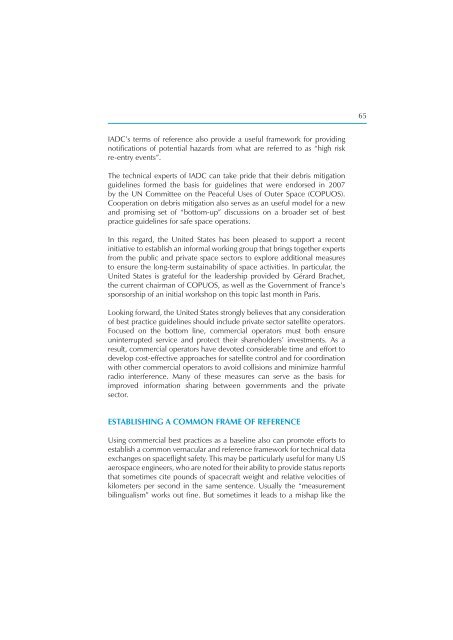Security in Space The Next Generation - UNIDIR
Security in Space The Next Generation - UNIDIR
Security in Space The Next Generation - UNIDIR
You also want an ePaper? Increase the reach of your titles
YUMPU automatically turns print PDFs into web optimized ePapers that Google loves.
IADC’s terms of reference also provide a useful framework for provid<strong>in</strong>g<br />
notifi cations of potential hazards from what are referred to as “high risk<br />
re-entry events”.<br />
<strong>The</strong> technical experts of IADC can take pride that their debris mitigation<br />
guidel<strong>in</strong>es formed the basis for guidel<strong>in</strong>es that were endorsed <strong>in</strong> 2007<br />
by the UN Committee on the Peaceful Uses of Outer <strong>Space</strong> (COPUOS).<br />
Cooperation on debris mitigation also serves as an useful model for a new<br />
and promis<strong>in</strong>g set of “bottom-up” discussions on a broader set of best<br />
practice guidel<strong>in</strong>es for safe space operations.<br />
In this regard, the United States has been pleased to support a recent<br />
<strong>in</strong>itiative to establish an <strong>in</strong>formal work<strong>in</strong>g group that br<strong>in</strong>gs together experts<br />
from the public and private space sectors to explore additional measures<br />
to ensure the long-term susta<strong>in</strong>ability of space activities. In particular, the<br />
United States is grateful for the leadership provided by Gérard Brachet,<br />
the current chairman of COPUOS, as well as the Government of France’s<br />
sponsorship of an <strong>in</strong>itial workshop on this topic last month <strong>in</strong> Paris.<br />
Look<strong>in</strong>g forward, the United States strongly believes that any consideration<br />
of best practice guidel<strong>in</strong>es should <strong>in</strong>clude private sector satellite operators.<br />
Focused on the bottom l<strong>in</strong>e, commercial operators must both ensure<br />
un<strong>in</strong>terrupted service and protect their shareholders’ <strong>in</strong>vestments. As a<br />
result, commercial operators have devoted considerable time and effort to<br />
develop cost-effective approaches for satellite control and for coord<strong>in</strong>ation<br />
with other commercial operators to avoid collisions and m<strong>in</strong>imize harmful<br />
radio <strong>in</strong>terference. Many of these measures can serve as the basis for<br />
improved <strong>in</strong>formation shar<strong>in</strong>g between governments and the private<br />
sector.<br />
ESTABLISHING A COMMON FRAME OF REFERENCE<br />
Us<strong>in</strong>g commercial best practices as a basel<strong>in</strong>e also can promote efforts to<br />
establish a common vernacular and reference framework for technical data<br />
exchanges on spacefl ight safety. This may be particularly useful for many US<br />
aerospace eng<strong>in</strong>eers, who are noted for their ability to provide status reports<br />
that sometimes cite pounds of spacecraft weight and relative velocities of<br />
kilometers per second <strong>in</strong> the same sentence. Usually the “measurement<br />
bil<strong>in</strong>gualism” works out fi ne. But sometimes it leads to a mishap like the<br />
65








